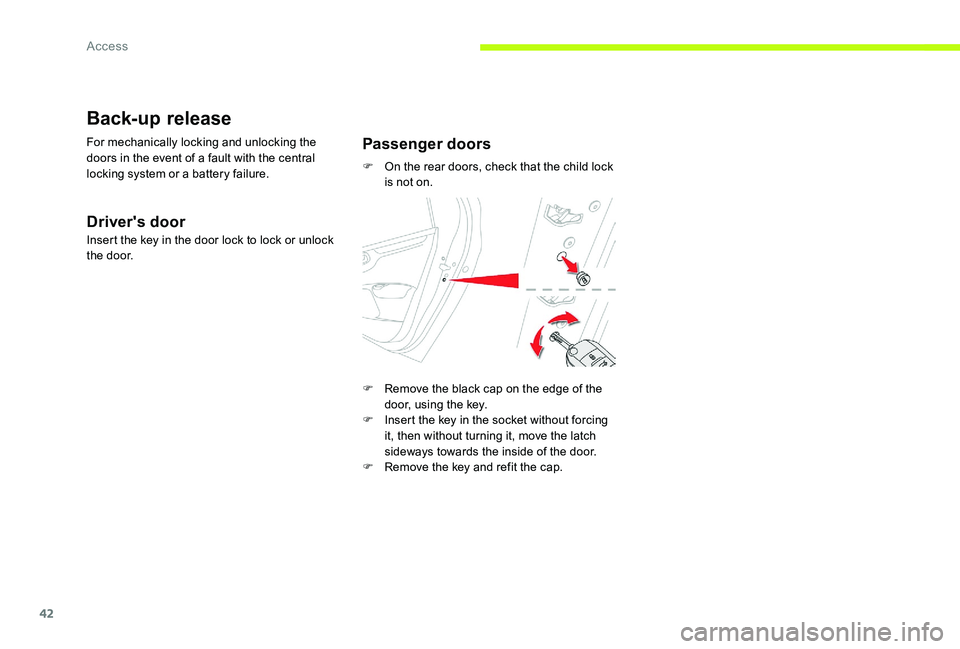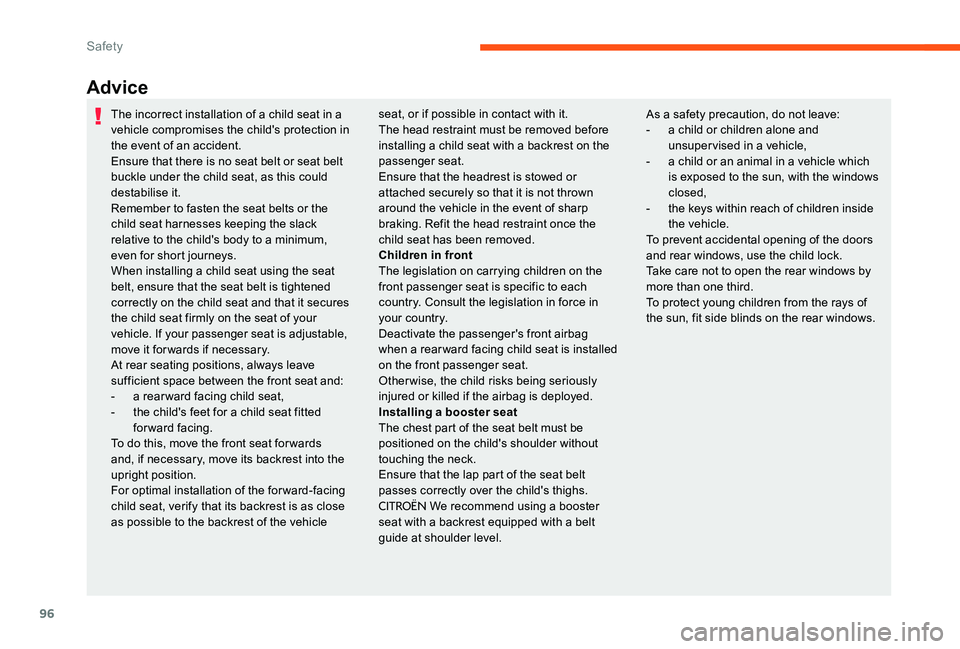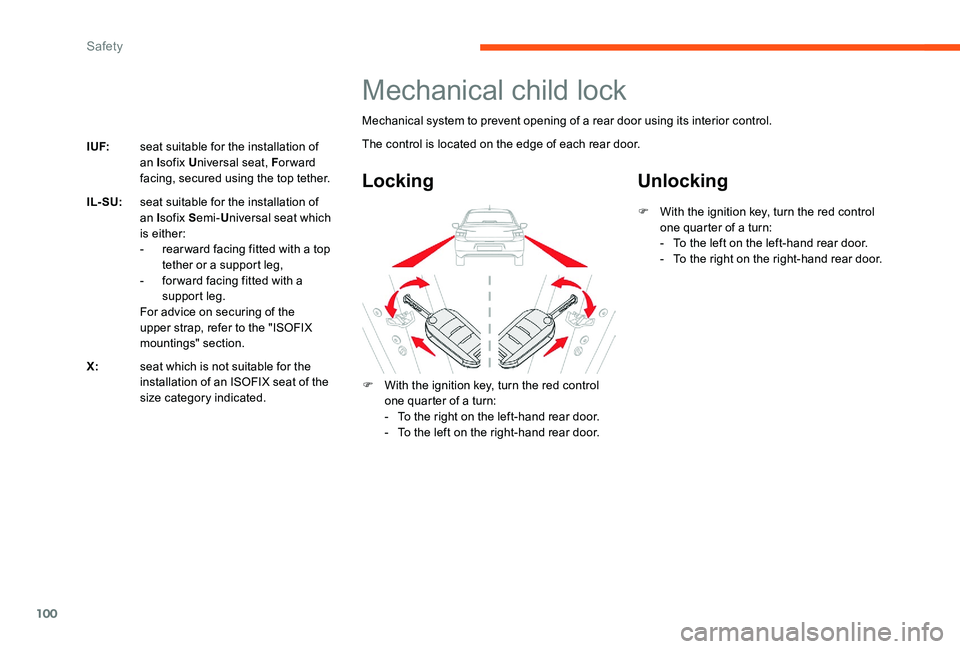key CITROEN C-ELYSÉE 2017 Handbook (in English)
[x] Cancel search | Manufacturer: CITROEN, Model Year: 2017, Model line: C-ELYSÉE, Model: CITROEN C-ELYSÉE 2017Pages: 306, PDF Size: 9.34 MB
Page 44 of 306

42
Back-up release
For mechanically locking and unlocking the
doors in the event of a fault with the central
locking system or a battery failure.
Driver's door
Insert the key in the door lock to lock or unlock
the door.
Passenger doors
F On the rear doors, check that the child lock is not on.
F
R
emove the black cap on the edge of the
door, using the key.
F
I
nsert the key in the socket without forcing
it, then without turning it, move the latch
sideways towards the inside of the door.
F
R
emove the key and refit the cap.
Access
Page 47 of 306

45
Electric Windows
Manual controls
Turn the window handle located on the door
trim panel.
Electric controls
Model with front electric windows
Model with front and rear electric windows1
Left-hand front.
2 Right-hand front.
3 Right-hand rear.
4 Left-hand rear.
5 Deactivating the rear electric window
switches.
To open or close the window, press or pull
the switch. The window stops as soon as you
release the switch.
The electric window controls remain
active for approximately 45 seconds after
ignition is turned off, or until a front door is
opened. During this period of 45 seconds,
if you open a door while operating a
window, the window stops. Any new
electric window command will be ignored
until ignition is switched back on. With the warning light on, the switches are
deactivated. With the warning light off, the
switches are active.
Deactivating the rear window
controls
For the safety of your children, press
this button to deactivate all the rear
window controls, irrespective of their
positions.
Always remove the key from the ignition
when leaving the vehicle, even for a short
time.
If an electric windows meets an obstacle
during operation, you must reverse the
movement of the window. To do this, press
the appropriate switch.
When operating the passenger electric
window switches, the driver must ensure
that no one is preventing the windows
from closing correctly.
The driver must ensure that the
passengers use the electric windows
c o r r e c t l y.
Be particularly aware of children when
operating the windows.
2
Access
Page 71 of 306

69
Courtesy lights
ACourtesy lights
B Map reading lights
Front and rear courtesy lights
In permanent lighting mode, the lighting
time varies according to the circumstances:
-
W
hen the ignition is off, approximately
ten minutes.
-
I
n energy savings mode, approximately
thirty seconds.
-
W
hen the engine is running, no limit.
Front map reading lights
F With the ignition on, press the corresponding switch.
In this position, the courtesy light
comes on gradually:
- When unlocking the vehicle.
-
W hen the key is removed from the ignition
switch.
-
W
hen opening a door.
-
W
hen actuating the locking button on the
remote control in order to locate your vehicle.
It switches off gradually:
-
W
hen locking the vehicle.
-
W
hen the ignition is switched on.
-
3
0 seconds after the last door is closed.Permanently off.
Permanent lighting.
4
Lighting and visibility
Page 86 of 306

84
DeploymentDeactivation
Malfunction
If this warning light comes on in the
instrument panel, you must contact
a
CITROËN dealer or a qualified
workshop to have the system
checked. The air bags may no
longer be deployed in the event of a
serious impact.
Reactivation
When you remove the rear ward facing child
seat, with the ignition off , turn the switch to
the ON position to reactivate the air bag and so
assure the safety of your front passenger in the
event of an impact.
Only the passenger's front air bag can be
deactivated.
F
W
ith the ignition off , insert the key into
the passenger air bag deactivation switch.
F
T
urn it to the "OFF" position.
F
R
emove the key keeping the switch in this
position.
When the ignition is on, this warning
light comes on in the instrument
panel and stays on while the air bag
is deactivated. To assure the safety of your child,
the passenger's front air bag must be
deactivated when you install a "rear ward
facing" child seat on the front passenger
seat. Otherwise, the child risks being
seriously injured or killed if the air bag is
deployed.
The air bags are deployed, except the
passenger's front air bag if it has been
deactivated, in the event of a serious front
impact to all or part of the front impact zone A ,
in the longitudinal centreline of the vehicle on a
horizontal plane and directed from the front to
the rear of the vehicle.
The front air bag inflates between the thorax
and head of the front occupant of the vehicle
and the steering wheel, driver's side, and the
dashboard, passenger's side, to cushion their
for ward movement.
Safety
Page 98 of 306

96
Advice
The incorrect installation of a child seat in a
vehicle compromises the child's protection in
the event of an accident.
Ensure that there is no seat belt or seat belt
buckle under the child seat, as this could
destabilise it.
Remember to fasten the seat belts or the
child seat harnesses keeping the slack
relative to the child's body to a minimum,
even for short journeys.
When installing a child seat using the seat
belt, ensure that the seat belt is tightened
correctly on the child seat and that it secures
the child seat firmly on the seat of your
vehicle. If your passenger seat is adjustable,
move it for wards if necessary.
At rear seating positions, always leave
sufficient space between the front seat and:
-
a r
ear ward facing child seat,
-
t
he child's feet for a child seat fitted
forward facing.
To do this, move the front seat for wards
and, if necessary, move its backrest into the
upright position.
For optimal installation of the forward-facing
child seat, verify that its backrest is as close
as possible to the backrest of the vehicle seat, or if possible in contact with it.
The head restraint must be removed before
installing a child seat with a backrest on the
passenger seat.
Ensure that the headrest is stowed or
attached securely so that it is not thrown
around the vehicle in the event of sharp
braking. Refit the head restraint once the
child seat has been removed.
Children in front
The legislation on carrying children on the
front passenger seat is specific to each
country. Consult the legislation in force in
your country.
Deactivate the passenger's front airbag
when a rear ward facing child seat is installed
on the front passenger seat.
Otherwise, the child risks being seriously
injured or killed if the airbag is deployed.
Installing a booster seat
The chest part of the seat belt must be
positioned on the child's shoulder without
touching the neck.
Ensure that the lap part of the seat belt
passes correctly over the child's thighs.
CITROËN We recommend using a booster
seat with a backrest equipped with a belt
guide at shoulder level. As a safety precaution, do not leave:
-
a c
hild or children alone and
unsupervised in a vehicle,
-
a c
hild or an animal in a vehicle which
is exposed to the sun, with the windows
closed,
-
t
he keys within reach of children inside
the vehicle.
To prevent accidental opening of the doors
and rear windows, use the child lock.
Take care not to open the rear windows by
more than one third.
To protect young children from the rays of
the sun, fit side blinds on the rear windows.
Safety
Page 102 of 306

100
I UF:seat suitable for the installation of
an Isofix U niversal seat, F or ward
facing, secured using the top tether.
IL- SU: seat suitable for the installation of
an Isofix S emi-Universal seat which
is either:
-
r
ear ward facing fitted with a top
tether or a support leg,
-
f
or ward facing fitted with a
support leg.
For advice on securing of the
upper strap, refer to the "ISOFIX
mountings" section.
X: seat which is not suitable for the
installation of an ISOFIX seat of the
size category indicated.
Mechanical child lock
Mechanical system to prevent opening of a rear door using its interior control.
The control is located on the edge of each rear door.
Locking Unlocking
F With the ignition key, turn the red control
one quarter of a turn:
-
T
o the right on the left-hand rear door.
-
T
o the left on the right-hand rear door. F
W
ith the ignition key, turn the red control
one quarter of a turn:
-
T
o the left on the left-hand rear door.
-
T
o the right on the right-hand rear door.
Safety
Page 104 of 306

102
Starting-switching off the engine
Anti-theft protection
Electronic engine immobiliser
The key contains an electronic chip which has
a special code. When the ignition is switched
on, this code must be recognised in order for
starting to be possible.
This electronic engine immobiliser locks the
engine management system a few minutes
after the ignition is switched off, and prevents
the engine being started by anyone who does
not have the key.
or In the event of a fault, you are
informed by the illumination of this
warning light, an audible signal and
a message in the screen.
In this case, your vehicle will not start; contact
a
CITROËN dealer as soon as possible.
Keep safely, away from your vehicle, the
label attached to the keys given to you on
when you purchased your vehicle.
Key star ter
It has 3 positions:
- position 1 (Stop): insert and removing the
key, steering column locked,
-
position 2 (Ignition on) : steering column
unlocked, ignition on, Diesel preheating,
engine running,
-
position 3 (Starting) .
Ignition on position
It allows the use of the vehicle's electric
equipment or portable devices to be charged.
Once the state of charge of the battery drops
to the reserve level, the system switches to
energy economy mode: the power supply is
cut off automatically to preserve the remaining
battery charge.
Avoid attaching heavy objects to the key
or the remote control, which would weigh
down on its blade in the ignition switch
and could cause a malfunction.
It could adversely affect the deployment of
the front airbag.
Driving
Page 105 of 306

103
Starting the engine
The parking brake must be applied.
F
W
ith a manual gearbox, place the gear
lever in neutral then depress the clutch
pedal fully.
F
W
ith an automatic gearbox, select position
P, then firmly press the brake pedal.
F
W
ith an electronic gearbox, select position
N then firmly press the brake pedal.
F
I
nsert the key into the ignition switch; the
system recognises the code.
F
U
nlock the steering column by
simultaneously turning the steering and the
key.
In certain cases, you may have to turn
the steering wheel energetically to move
the wheels (for example if the wheels are
braced against a kerb). F
W ith a petrol engine, operate the starter
motor by turning the key to position 3
without pressing the accelerator pedal,
until the engine starts. Once the engine is
running, release the key.
F
W
ith a Diesel engine, turn the key to
position 2 , ignition on, to operate the
engine pre-heating system.
Wait until this warning light goes off
in the instrument panel then operate
the starter motor by turning the key
to position 3 without pressing the
accelerator pedal, until the engine
starts. Once the engine is running,
release the key.
In winter conditions, the lighting time of
the indicator light is longer. When the
engine is warm, the indicator light does
not come on. If the engine does not start immediately,
turn off the ignition. Wait a few minutes
before restarting. If after a few attempts
the engine does not start, do not persist:
you risk damaging the starter and the
engine. Contact a
CITROËN dealer or a
qualified workshop.
In temperate conditions, do not leave
the engine at idle to warm up but move
off straight away and drive at moderate
speed.
Never leave the engine running in
an enclosed area without adequate
ventilation: internal combustion engines
emit toxic exhaust gases, such as carbon
monoxide. There is a risk of poisoning and
death!
In severe wintry conditions (temperature
below -23°C), the engine should be left at
idle for four minutes before moving off to
ensure the correct operation and life of the
mechanical parts of your vehicle, engine
and gearbox.
6
Driving
Page 106 of 306

104
Switching off the engine
F Stop the vehicle.Energy savings mode
For more information on the Energy
economy mode refer to the
corresponding section.
F
W
ith the engine running in idle, turn the key
to position 1 .
F
R
emove the key from the ignition switch.
F
T
o lock the steering column, turn the
steering until it locks.
To facilitate unlocking of the steering column,
it is recommended that the wheels be
returned to the straight ahead position
before switching off the engine.
F
C
heck that the parking brake is
correctly applied, particularly on
sloping ground. After switching off the engine (position
1- Stop
), for a maximum of 30 minutes you
can still use functions such as the audio and
communications system, the wipers, dipped
beam headlights, courtesy lights, ...
Never turn the ignition off before the
vehicle is at a complete stop. With the
engine off, the braking and steering
assistance systems are also cut off: risk
of loss of control of the vehicle.
When you leave the vehicle, keep the key
with you and lock the vehicle.
When opening the driver's door, an alert
message is displayed, accompanied by
an audible signal, to remind you that the
key is still in the ignition switch at position
1 (Stop) .
If the key has been left in the ignition
switch at position 2 (Ignition on) , the
ignition will be switched off automatically
after one hour.
To switch the ignition back on, turn the key
to position 1 (Stop) , then back to position
2 (Ignition on) .
Key left in the "Ignition on" position
Driving
Page 118 of 306

116
Stop & Start
The Stop & Start system puts the engine
temporarily into standby - STOP mode - during
stops in the traffic (red lights, traffic jams, or
other...). The engine restarts automatically -
START mode - as soon as you want to move
off. Restarting occurs instantly, quickly and
silently.
Per fect for urban use, the Stop & Start system
reduces fuel consumption and exhaust
emissions as well as the noise level when
stationary.Operation
Going into engine STOP mode
For your comfort, during parking
manoeuvres, STOP mode is not available
for a few seconds after coming out of
reverse gear.
The STOP mode does not affect the
operation of vehicle systems such as
braking, power steering...
Never refuel with the engine in STOP
mode; you must switch off the ignition
using the key.With an electronic gearbox, the
"ECO" indicator illuminates in the
instrument panel and the engine
goes into standby when and the
brake pedal is pressed or the gear
selector is moved into position N
while the vehicle is stationary.
Special cases: STOP mode not
available
STOP mode is not invoked when:
-
T he driver's door is open.
-
T
he driver's seat belt is not fastened.
-
T
he engine is needed to maintain a
comfortable temperature in the passenger
compartment.
-
D
emisting is active.
-
S
ome special conditions (battery charge,
engine temperature, braking assistance,
climate control...) need it to control the
system.
The "ECO" warning light flashes for
a few seconds, then goes off.
This operation is perfectly normal.
Driving